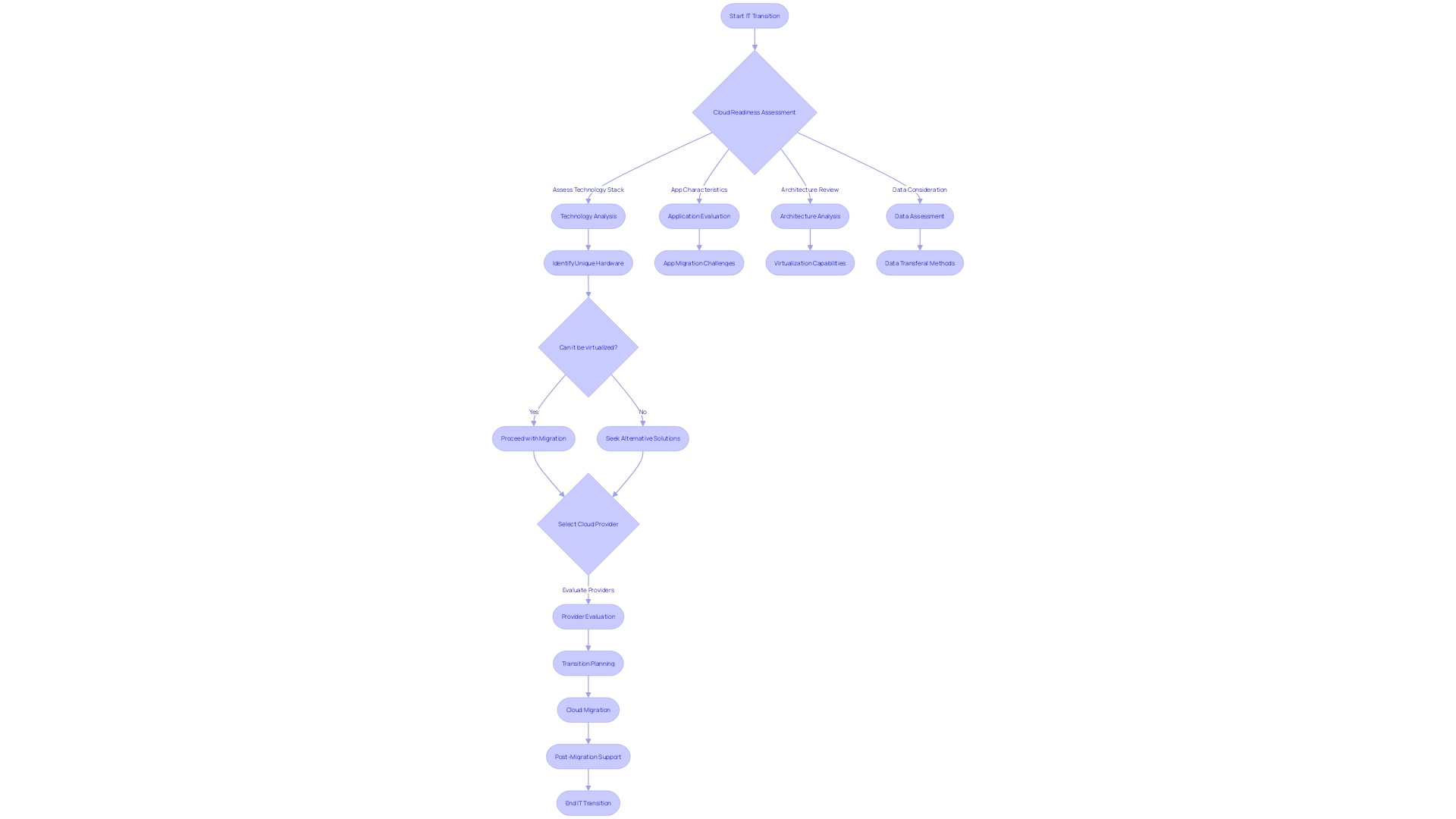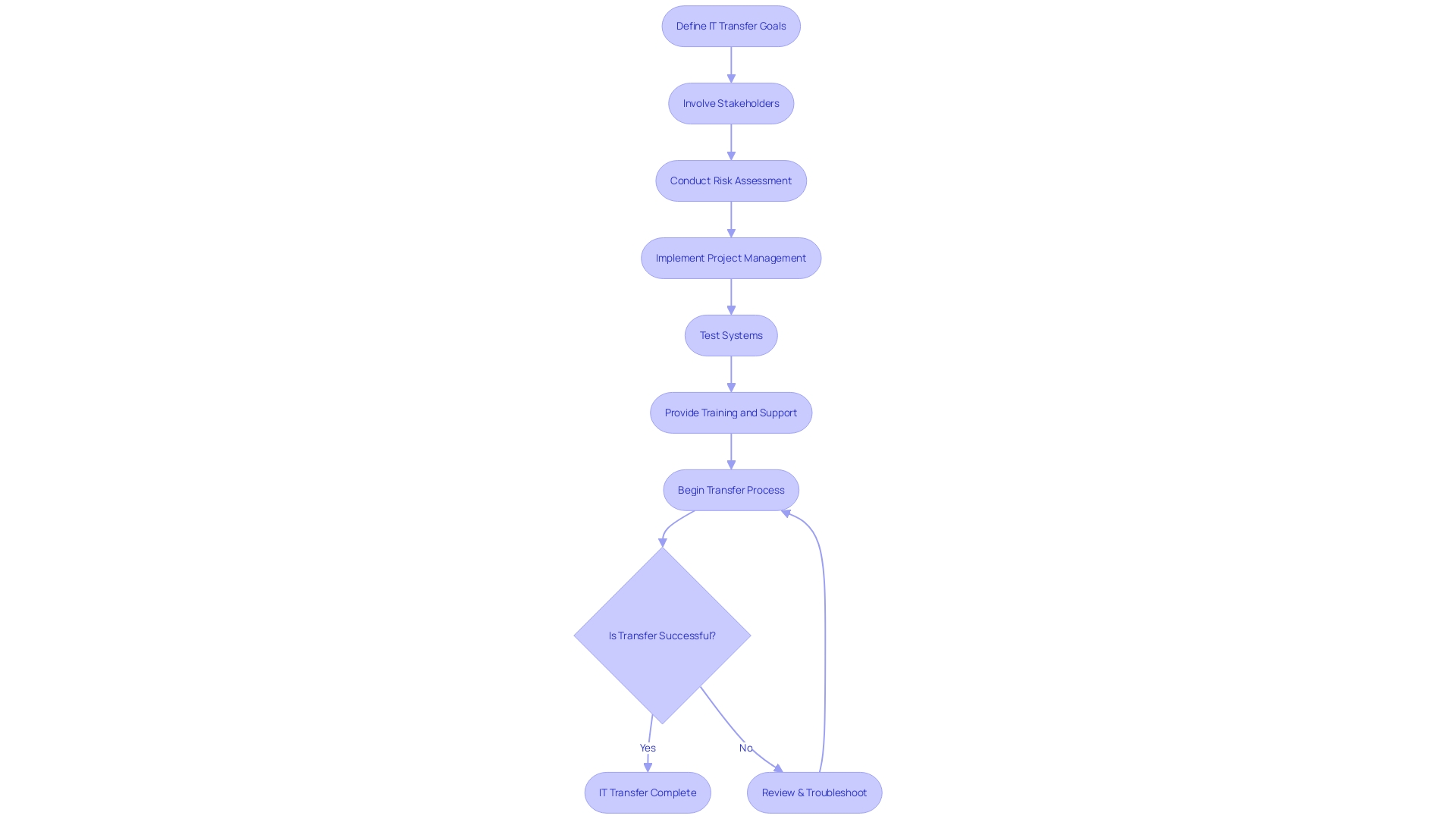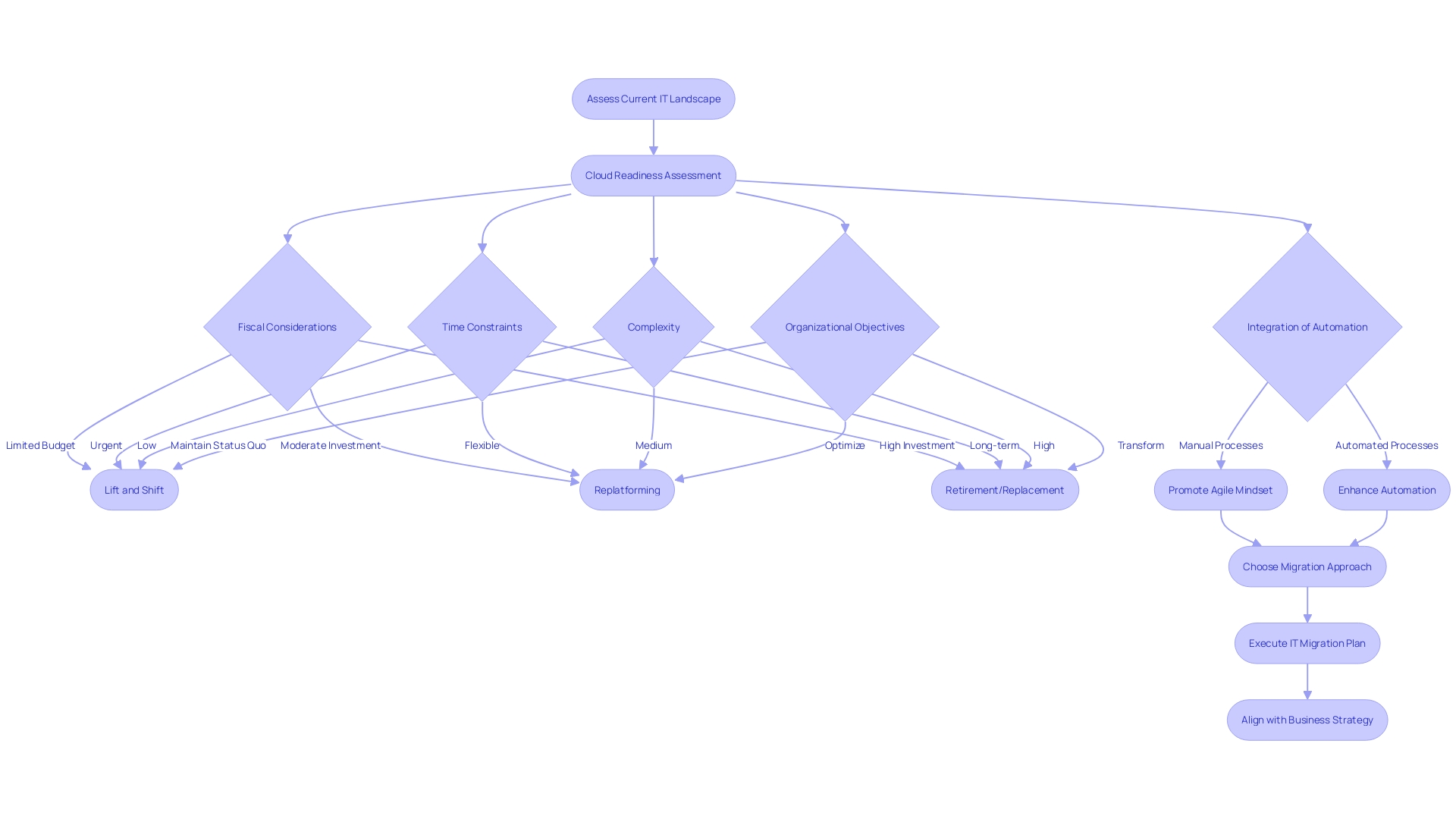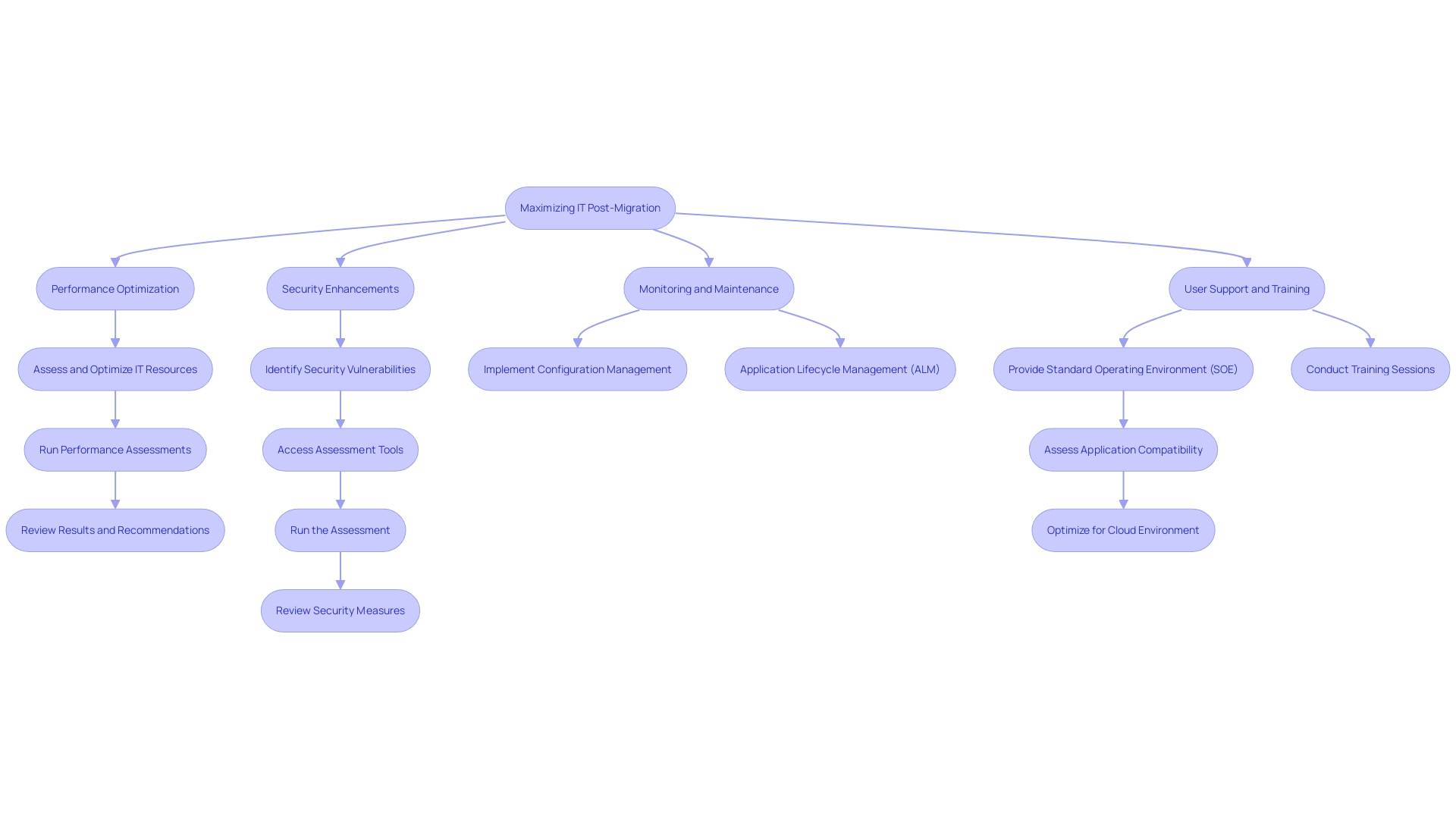Introduction
IT migration is a complex process that involves transferring an organization's IT infrastructure, applications, and data to a new environment. With different types of IT migration, understanding each category is crucial for a successful implementation. This article explores the key elements of a successful IT migration, the assessment and planning phase, choosing the right migration strategy, designing the migration plan, preparing the environment, executing the migration, testing and validation, post-migration optimization and monitoring, best practices, and common challenges and solutions.
By following these guidelines and insights from organizations like Lincoln Financial Group, readers can develop a robust IT migration strategy that aligns with their business objectives and paves the way for future growth and innovation.
Understanding IT Migration Types
IT transition, a pivotal process in the technological landscape, involves transitioning an organization's IT infrastructure, applications, and data from one environment to another. With different forms of IT transfer, understanding each category is crucial for a successful strategy implementation.
- Infrastructure relocation involves moving entire IT frameworks, such as servers, networks, and storage, to a new location or cloud environment.
- Application relocation moves specific software systems to alternative platforms.
- Data transferal is the movement of data across databases or storage systems.
Factors to take into account for a successful transition involve a multiprovider approach, early cooperation, and careful security preparation. Executives at Lincoln Financial Group, such as Satyendra Kumar and Rob Klaczak, demonstrate this through their journey to the cloud. By prioritizing applications based on business necessities and adopting a dynamic planning approach that incorporated both automation and manual maneuvers, they manifested a successful transition.
Moreover, the plan for moving must consider the scalability of equipment and the changing requirements of data center efficiency. With industry news highlighting the flexibility of organizations in choosing between cloud-based solutions and on-premises infrastructures, the decision-making process becomes complex. A deep comprehension of the requirements of your organization, existing infrastructure, and the possible advantages and obstacles of cloud environments will steer the creation of a strong IT transition plan.

Key Elements of a Successful IT Migration
Developing a plan for IT transfer is a complex undertaking that requires a careful approach. The following key components are integral to the process:
-
Clearly expressing goals related to movement, such as enhanced performance, expense reduction, or enhanced security, is crucial.
-
It is crucial to ensure all relevant stakeholders are involved in the process of transitioning, from IT personnel to business units and end-users, to address their requirements and reservations.
-
Conducting a thorough risk assessment to pinpoint potential issues and devising countermeasures is crucial. This may include preventing information loss, minimizing system downtime, and resolving compatibility problems.
-
Implementing a robust project management structure is essential to supervise the migration, encompassing timelines, milestones, and the distribution of resources.
-
Rigorous testing of the migrated systems is necessary to confirm their functionality, performance, and the integrity of the data they contain.
-
Providing comprehensive training and support to end-users is essential to ease the transition to the new technological environment.
These components form the foundation of a smooth and efficient IT transition. For example, Lincoln Financial Group's transition from legacy systems to a cloud-based architecture exemplifies the implementation of these principles. The organization adopted a multiprovider, multipartner approach, prioritized applications by business necessity, and fostered a collaborative environment. This strategic planning, combined with a focus on security and the creation of a Wikipedia-style playbook for information sharing, highlights the importance of a dynamic and inclusive approach to IT transition. Similarly, a readiness assessment can help in evaluating the current technology stack, application characteristics, and architecture, thus enabling a successful transition to the cloud for applications that may not be readily virtualizable.

Assessment and Planning Phase
The initial stage of IT migration, encompassing assessment and planning, is pivotal for the transition's success. It starts with a comprehensive inventory and assessment of existing IT assets, applications, and data. This step involves examining dependencies, performance, and compatibility with the future environment. Afterwards, the extent and duration of the movement are determined, identifying which assets will be transferred and establishing a schedule for the process.
Technical requirements for the transfer are then identified, including necessary hardware, software, and network infrastructure. A risk assessment is crucial at this juncture to pinpoint potential obstacles and formulate strategies to mitigate them. This includes evaluating the impact of the transition on business operations and preparing contingency plans.
One noteworthy instance is Lincoln Financial Group's transition from outdated legacy platforms to a dynamic cloud-based architecture. In this case, essential areas of focus included adopting a multiprovider, multipartner strategy and fostering early collaboration across organizational boundaries. The organization's security posture was rigorously analyzed to ensure legacy system nuance understanding and current standard alignment. Through a Wikipedia-style playbook, they achieved democratized information sharing across the organization, prioritizing applications based on business imperatives and incorporating a dynamic planning approach that melded automation with manual processes.
In the broader perspective, the ongoing advancement of technologies like IoT and the increasing focus on digital abilities highlight the necessity for careful planning in IT transitions. Establishing clear goals, as in the case of Lincoln Financial, allows for addressing specific business challenges, such as reducing operating costs or transitioning to more adaptable environments.
In the end, the evaluation and preparation stage is about establishing a strong base for a prosperous IT transition, utilizing knowledge from past experiences and market patterns to guide a methodical and future-oriented strategy.
Choosing the Right Migration Strategy
Developing the ideal IT migration plan is crucial for business continuity and future expansion. Organizations may consider a spectrum of approaches:
- Lift and Shift: This method transports an organization's IT setup to a new environment with no substantial modifications, aiming for minimal disruption during the transition.
- Replatforming: Here, applications are moved to a new platform or infrastructure with limited adjustments to their code or architecture, balancing familiarity and new capabilities. Through refactoring, applications are reimagined and restructured to fully utilize the new environment's features, often leading to improved performance and scalability.
- Retirement/Replacement: This involves evaluating existing systems to determine which are outdated or redundant, making way for modern, efficient solutions.
The choice of strategy hinges on various factors like fiscal considerations, time constraints, complexity, and organizational objectives. It's important to assess the current IT landscape thoroughly, identifying the number of physical and virtual devices, storage volumes, databases, and particularly the applications and workloads they support.
Furthermore, successful transitions frequently require dynamic planning, where automation integrates with manual procedures. Insights from industry experiences, like Lincoln Financial's transition, highlight the significance of promoting an agile mindset, collaboration across organizational boundaries, and addressing security from the beginning to guarantee a smooth change.
In the rapidly evolving tech landscape, where IoT and AI are reshaping business operations, and as organizations like HPE continue to expand their data center capabilities, the approaches for IT transfer must be adaptable, future-forward, and aligned with the overarching business strategy to ensure resilience and competitive advantage.

Designing the Migration Plan
To guarantee a smooth and efficient IT transfer, it's crucial to start the process with a strong transfer plan. The first step involves outlining clear goals for system enhancement, cost efficiency, or strengthening security measures. A committed team with the necessary knowledge must be assembled to guide and carry out the transfer. Creating a comprehensive timeline is crucial, covering pre-migration preparations, the actual movement, and follow-up activities to ensure continuity and system integrity. Allocating resources judiciously, both in terms of technology and personnel, is essential for a smooth transition. Furthermore, every migration activity should be thoroughly documented, encompassing transfer of information, application migration, and infrastructure overhaul.
Reflecting on real-world experiences, Satyendra Kumar highlighted the importance of a multiprovider, multi partner strategy and the early integration of partners to foster collaboration. Security considerations were paramount, ensuring legacy system nuances were comprehended and current standards met in the target architecture. A comprehensive, Wikipedia-style playbook enabled widespread data collection and knowledge sharing across the organization. Applications were prioritized based on business imperatives, processing times, and sensitivity, with a mix of automation and manual processes for dynamic planning.
Rob Klaczak from Lincoln Financial Group described their path towards a dynamic cloud-based structure, motivated by goals of decreasing operational expenses, specialized software licensing costs, and moving towards a modern, adaptable setting. The undertaking was critical to shift from a fixed-cost legacy setup to a more scalable and cost-effective cloud infrastructure.
Amidst the evolving IT landscape, IT executives must stay abreast of market movements and cybersecurity developments. As IT infrastructures become increasingly integral to organizational success, IT budgets and investments are pivotal, with global spending on tech goods and services reaching trillions of dollars, demonstrating the significant role of technology in value creation.
To sum up, developing a well-thought-out plan for transitioning is not just about technical preparedness but also about forming strategic alliances, maintaining security, and optimizing resources, guaranteeing that the transition promotes the organization's goals and sets the stage for future innovation and expansion.

Preparing the Environment for Migration
When preparing for IT movement, it's crucial to carefully plan and address different aspects of the current environment to guarantee a successful transition. Assessing infrastructure readiness involves a thorough evaluation of current systems and may require upgrades or changes to accommodate the new setup. This process should not be underestimated, as it forms the backbone of migration.
Data preparation is another critical component. It's about more than just transferring information; it's about ensuring its accuracy and integrity after transfer. Cleansing and validating information prevent the corruption of valuable records and ensure business continuity.
Implementing effective backup and disaster recovery strategies is crucial for mitigating risks linked to information loss and minimizing possible interruptions throughout the migration process. A robust mechanism will safeguard data, providing peace of mind and continuity of operations.
Network connectivity is the artery of migration, connecting the old and new surroundings. It requires careful planning to ensure that the transition is smooth and that the two environments can communicate effectively without bottlenecks.
The experience shared by leaders at Lincoln Financial Group underscores the importance of a multiprovider approach and the early involvement of partners. They emphasized the critical nature of security measures and the benefits of a dynamic planning approach that incorporates both automation and manual processes. Their success through agility, despite initial challenges, highlights the need for a flexible mindset during such transformative journeys.
Moreover, updates from companies such as HPE GreenLake and Azure Migrate indicate a rising inclination towards transitioning to the cloud, propelled by the demand for reliable, efficient, and cutting-edge platforms. These services are transforming the way we utilize the potential of information, with AI playing a crucial part in converting information into practical insights, thus highlighting the significance of a well-prepared transition plan.
Statistics from IDC highlight the imperative of digital transformation and the associated challenges in achieving strategic business outcomes. It's clear that careful planning and alignment of infrastructure investments are crucial for realizing these goals. The extensive study of science and analytics experts, as stated by Eric Siegel, further emphasizes the scope and complexity of factors involved in successful technology implementations, including IT transfer.
Integrating these considerations into your transition plan will tackle the complexities of moving to a modern, cloud-based architecture, ensuring that your organization reaps the full benefits of a digital-first approach.
Executing the Migration
The implementation stage is a critical juncture in IT transition, as it entails the real transfer of information, applications, and infrastructure. Each step must be executed with precision to ensure a smooth transition and alignment with the organization's strategic goals.
This procedure involves transferring information from the current environment to the new one. It is crucial to choose tools and techniques for transferring data that align with the specific data types and structures involved. For example, Grafana Cloud utilizes a database structure that supports single-tenant databases, showcasing the requirement for customized relocation solutions.
Applications must be transferred from the old platform to the new one with careful attention to maintaining their functionality and compatibility, ensuring a smooth transition. Since cloud relocation approaches differ, it's crucial to take into account the distinctive aspects of each application. For instance, applications developed on distinctive hardware that cannot be virtualized, like particular IoT apps, may encounter additional difficulties when transitioning.
Infrastructure relocation: This involves moving physical and virtual infrastructure components - servers, storage, and networks - to the new environment. An extensive evaluation of the current IT infrastructure's ability to handle workload and grow is essential, as emphasized in a roadmap development stage where assessment of hardware, software, networks, and centers is advised.
Testing and validation is crucial after the transfer to ensure that all systems function properly and meet the predetermined criteria. This stage can reveal possible problems with the evolution of the structure, as observed in application development, where the movement of information can introduce flaws if not managed correctly.
Closely monitoring the movement and addressing issues promptly is essential. A plan for transferring information can reduce risks, guaranteeing the dependability of the transfer. The significance of data in business cannot be emphasized enough, and a structured transfer process can help prevent typical obstacles.
Migration success is often measured by specific KPIs, which should be defined in the planning stages. As observed in the case of LinkedIn's transition to Azure Linux, these KPIs can steer the process and clarify the definition of a successful move.
The global trend towards IoT adoption, such as in home automation, underscores the importance of incorporating modern technologies into infrastructure transition plans. This guarantees that the new setting is prepared to manage the most recent progressions and backings the development and advanced change activities of the association.
In summary, a well-defined execution phase is crucial for a successful IT transfer. It requires careful consideration of the organization's current infrastructure, clear goals, and a strategic approach to managing the complexities inherent in transferring data, applications, and infrastructure to a new environment.

Testing and Validation
The complexities of IT transfer require careful testing and validation to ensure a successful transition. This multifaceted phase encompasses:
-
Functional Testing: This involves a rigorous examination of the migrated systems to confirm they fulfill their intended purpose and adhere to the defined functional criteria.
-
Performance Testing: Here, the systems are assessed to verify their efficiency under various workloads and scenarios, ensuring they operate at peak performance.
-
Security testing is crucial for maintaining the integrity of the process, as it helps identify potential vulnerabilities and implements measures to safeguard the migrated ecosystem.
-
User Acceptance Testing: This stage engages the end-users, allowing them to test the systems in real-world scenarios to ensure that the final product aligns with their requirements and expectations.
To illustrate the importance of thorough testing and validation, consider the case of TBC Bank, a leading financial institution that underwent an agile transformation to reduce organizational complexity and expedite digital product delivery. As part of their strategic overhaul, they emphasized the need for rigorous testing protocols to maintain high standards of quality and functionality in their software systems, which are crucial for providing an exceptional banking experience.
Furthermore, recent news from the telecommunications industry, such as T-Mobile's pilot testing for pricing strategy adjustments, underscores the significance of testing in operational and strategic decision-making. These examples highlight that continuous evaluation and adaptation are indispensable in the face of the ever-evolving technological landscape.
Industry experts agree that software testing is not merely a phase but a continuous process that plays a critical role in the development lifecycle. It is instrumental in uncovering and rectifying bugs and defects early on, saving valuable time and resources while preventing minor issues from escalating into significant setbacks.
As organizations invest heavily in their IT infrastructure, recognizing the role of technology in value creation, the emphasis on robust testing frameworks becomes even more pronounced. With global spending on tech goods and services reaching astronomical figures, it is imperative that investments translate into reliable and effective technological solutions.
To summarize, the testing and validation phase is crucial for IT migration, guaranteeing that the new systems are safe, effective, and in line with user expectations, thus enabling a seamless transition to the post-migration context.

Post-Migration Optimization and Monitoring
Maximizing the IT post-migration is a multi-faceted process that is crucial for realizing the full potential of cloud adoption. After migrating to cloud-based platforms, organizations must undertake a series of strategic activities to ensure that the transition delivers on its promise of efficiency and stability.
-
Performance Optimization: Post-migration, it is essential to fine-tune your systems. This involves scrutinizing the current technology stack, application characteristics, architecture, and data to ensure they are fully optimized for cloud performance. Given that each IT asset has its own cost, performance, and complexity profile, this step is vital for achieving the desired efficiency.
-
Security Enhancements: Implementing robust security measures is non-negotiable to safeguard your digital assets in the cloud. Since cloud setups vary greatly from traditional IT configurations, it is crucial to establish improved security protocols to safeguard against evolving threats.
-
Monitoring and Maintenance: Establishing comprehensive monitoring is imperative to maintain the health of your IT environment. This means proactively identifying and addressing any issues or performance bottlenecks to ensure continuous operational excellence.
-
User Support and Training: It is equally important to support end-users through this transition. Providing ongoing training helps users to adapt to the new systems, which is critical for leveraging the cloud's full range of capabilities.
By highlighting these post-relocation activities, organizations can optimize the advantages of the IT transition. Research by Gartner suggests that by 2025, 85% of companies will embrace a cloud-first strategy, emphasizing the importance of a well-executed transfer and optimization plan. As organizations like the Guthrie Clinic have demonstrated, a holistic approach that encompasses technology, processes, and people is key to successful IT solutions and community well-being. Ultimately, these efforts contribute to the long-term success and agility of any organization venturing into the cloud.

Best Practices for IT Migration
Organizations undertaking IT transfer must participate in careful planning and implementation. The first step is to express clear goals and objectives that align with business needs. This could include prioritizing applications based on processing times and sensitivity, as was the case with Lincoln Financial's strategic move to a cloud-based architecture. Collaborative efforts across the board are crucial, involving all relevant stakeholders from the outset. This multiprovider, multipartner strategy not only fosters cooperation but also ensures a comprehensive understanding of security considerations, as highlighted by Satyendra Kumar's experience during their IT transformation journey.
A thorough assessment of the current IT landscape is paramount, identifying every asset and its dependencies. This involves not only taking stock of physical and virtual devices, storage, and databases but also understanding the applications and services running on them. Afterwards, a well-organized transfer plan must be created, providing a detailed schedule and allocating resources efficiently. It's imperative to test and validate the migrated systems meticulously, ensuring they meet the desired outcomes and performance standards.
Effective communication with end-users, coupled with adequate training and support, can significantly ease the transition, as user adoption is often a hurdle during such changes. Post-migration, establishing robust monitoring and maintenance processes is critical to ensure the new environment is stable, secure, and delivers the expected benefits. Organizations like Lincoln Financial have demonstrated the importance of an agile approach, enabling them to adapt to unforeseen challenges and deliver consistent results, despite the complexities of transitioning from legacy systems.
In this quickly changing tech environment, where IoT and cloud usage are increasing, organizations like LinkedIn have also demonstrated the importance of a carefully planned transition approach. Their transition to Microsoft Azure Linux exemplifies the intricate engineering and strategic planning required to update and modernize IT infrastructure successfully. It's evident that a dynamic strategy, combining automation with manual procedures, and a readiness to adjust are vital components that contribute to the triumph of any IT transition endeavor.
Common IT Migration Challenges and Solutions
Successful IT transfer strategies hinge on recognizing and proactively managing a variety of challenges. For instance, data integrity is paramount to avoid loss or corruption; robust backup and verification protocols are essential. During migrations, organizations like Lincoln Financial Group have experienced the need to minimize downtime and service disruption, which requires meticulous planning and clear communication with stakeholders. Compatibility testing is another critical step; it ensures a seamless transition by addressing potential compatibility issues ahead of time.
Change management is fundamental for guiding stakeholders through transitions. As observed in Lincoln Financial's transition from legacy platforms to a modern cloud-based architecture, a multiprovider, multipartner approach was crucial. The establishment of a Wikipedia-style playbook facilitated information sharing and fostered collaboration, which is crucial for security considerations and the nuanced understanding of legacy systems. Moreover, prioritizing applications based on business needs and blending automation with manual processes can improve efficiency and adaptability.
According to David S. Linthicum, a recognized industry expert, it's also about the mindset shift that accompanies the technological transformation. The right approach can lead to reduced operating costs and a more agile environment. Carina Parisella, head of tech at ANZ bank, emphasizes designing for talent retention, with her approaches leading to an 85% retention rate. This highlights the significance of aligning IT transition with broader organizational objectives, including talent management. The intersection of technology, strategy, and people is where successful IT migration takes place, reducing costs and enhancing productivity.

Conclusion
In conclusion, IT migration is a complex process that requires careful planning, execution, and optimization. Understanding the different types of IT migration is crucial for developing an effective strategy. Key elements of success include clear goals, stakeholder involvement, thorough assessment, well-structured plan, rigorous testing, user support, and robust monitoring.
Choosing the right migration strategy depends on factors like fiscal considerations, time constraints, complexity, and organizational objectives. The assessment and planning phase involves inventory assessment, defining scope and timeline, identifying technical requirements, and conducting risk assessments. Designing a migration plan includes delineating goals, assembling a dedicated team, establishing a detailed timeline, allocating resources, and documenting activities.
Preparing the environment requires assessing infrastructure readiness, data preparation, backup and disaster recovery, and network connectivity. During execution, data, applications, and infrastructure are transferred with precision. Testing and validation ensure functionality, performance, and security.
Post-migration optimization involves fine-tuning systems, enhancing security, establishing monitoring, and providing user support. Best practices include clear goals, stakeholder involvement, thorough assessment, well-structured plan, rigorous testing, user support, and robust monitoring. Common challenges include data integrity, downtime, compatibility, and change management.
Solutions include backup protocols, planning, compatibility testing, and a multiprovider strategy. Successful IT migration requires a strategic approach, collaboration, and adaptability. By following these guidelines and leveraging insights from organizations like Lincoln Financial Group, organizations can develop a robust IT migration strategy that aligns with their objectives and paves the way for growth and innovation.




